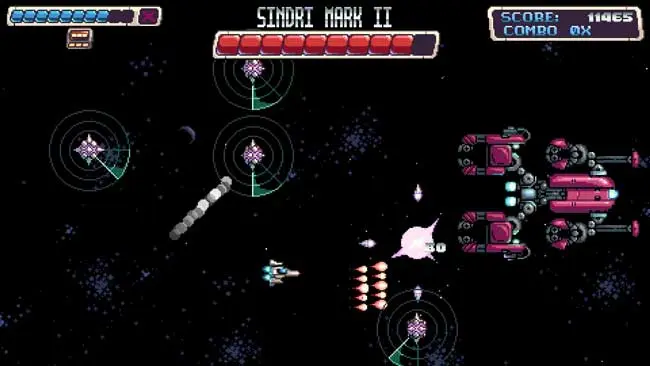
Habroxia immediately grabbed my attention for its retro arcade-style gameplay. As someone who grew up at the tail-end of the coin-op and NES era, I’ve always been fond of 2D space shooters like this.
One of my first experiences in the genre was Konami’s Life Force, which is a spinoff of Gradius. The game is known in Japan as Salamander. The NES version – which is the one that I played – is a fun and challenging shmup.
Habroxia is not exactly Gradius or Life Force, although it obviously attempts to channel the spirit of those games to mixed results. In fact, it is a game that desperately tries to mask itself as an ’80s-era space shooter without standing out or contributing a whole lot in its own right.
There are four different modes to play.
With the exception of the Story Mode, all of the modes are initially locked. Invasion Mode is unlocked after you complete level five of Story Mode. Rescue Mode is unlocked after completing level ten. Shield Maiden Mode is unlocked after beating the game.
The Story Mode is broken up into fifteen progressively more challenging levels. You initially have to play the levels sequentially. Once they are unlocked, you can go back and play them in any order that you want either for fun or to try to achieve a high score.
The levels are standard space shooter fare, perhaps even on the generic-looking side, and alternate between horizontal and vertical gameplay. The ships are all well-designed, including our hero’s ship and enemy ships, but the levels are rather uninspired compared to a game like Life Force. In fact, a lot of the elements repeat.
The various enemy ships have their own unique flying patterns and attacks. Some have simple, predictable laser shots that go in a straight line. Others have what appear to be heat-seeking missiles and wander in more complicated flying patterns that make them more difficult to track.
Most of the levels are capped off with boss fights, although there are two levels where your mission is to rescue stranded astronauts. The boss fights are generally more interesting than the standard enemies, but they are not particularly challenging.
Compared to other space shooters, these bosses are fairly weak both in terms of difficulty and design. Worse yet, the game repeats bosses in later levels, although they are nominally more challenging. For a game this short, there’s really no excuse for having repeating bosses.
In between levels is the ability to upgrade your ship. These upgrades include everything from increased health to improved attack power. The upgrades are purchased using in-game credits that you collect throughout the game’s fifteen missions.
The other modes feel somewhat tacked on.
The most substantive of them is Invasion Mode. This mode is more Space Invaders than Gradius. You are limited to strictly left or right movement with waves of enemies coming from the top of the screen downward. The game ends after you lose all of your health or one of the enemies reaches the bottom of the screen.
Rescue Mode just has you rescue stranded astronauts and destroy enemy ships across repeating segments of levels from the Story Mode. Shield Maiden Mode gives you a weak weapon and low health. Your objective is to survive as long as possible. Both of these modes are pretty forgettable.
On Sony’s platforms, Habroxia is a cross-buy title. If you buy the game on PS4, you get the PS Vita version. That probably won’t mean a whole lot for most people, but it does give you the option to take the game on the go if you still use your Vita.
For people who are obsessed with collecting PlayStation Trophies, Habroxia could be tempting. This is an easy Platinum Trophy. As someone who expected this game to be more difficult than it is, though, it is disappointing that the Trophies do not add any real challenge.
If you’ve noticed, that’s a theme with Habroxia. The game mimics retro classics but ultimately falls short. Sadly, games that are now over thirty years old are more original in terms of level design and boss fights.
Although I enjoyed my brief time with the game’s Story Mode – which is over basically before it begins – it just does not live up to the greatness of Konami’s space shooters of yesteryear. That’s not to say that it’s a bad game or unworthy of your time. It’s just a missed opportunity.
Game Freaks 365 received a free review code.

